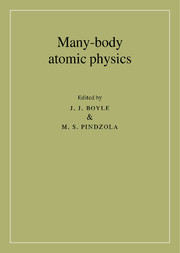Book contents
- Front Matter
- Contents
- Foreword
- Contributors
- Preface
- Acknowledgements
- Part 1 ATOMIC STRUCTURE
- Part 2 PHOTOIONIZATION OF ATOMS
- 4 Many-body effects in single photoionization processes
- 5 Photoionization dominated by double excitation in two-electron and divalent atoms
- 6 Direct double photoionization in atoms
- 7 Photoelectron angular distributions
- Part 3 ATOMIC SCATTERING: A. General Considerations
- Part 3 ATOMIC SCATTERING: B. Low-order applications
- Part 3 ATOMIC SCATTERING: C. All-order applications
- Appendix: Units and notation
- References
- Index
4 - Many-body effects in single photoionization processes
Published online by Cambridge University Press: 22 September 2009
- Front Matter
- Contents
- Foreword
- Contributors
- Preface
- Acknowledgements
- Part 1 ATOMIC STRUCTURE
- Part 2 PHOTOIONIZATION OF ATOMS
- 4 Many-body effects in single photoionization processes
- 5 Photoionization dominated by double excitation in two-electron and divalent atoms
- 6 Direct double photoionization in atoms
- 7 Photoelectron angular distributions
- Part 3 ATOMIC SCATTERING: A. General Considerations
- Part 3 ATOMIC SCATTERING: B. Low-order applications
- Part 3 ATOMIC SCATTERING: C. All-order applications
- Appendix: Units and notation
- References
- Index
Summary
Introduction
The process of single photoionization occurs when an atom or molecule absorbs a photon and ejects a single electron. Photoionization studies of multi-electronic systems can provide excellent portraits of the many-body effects that lie within both the initial target state and the final state consisting of the ion plus the photoelectron. Important examples of many-body effects include autoionizing resonances, giant shape resonances, relaxation, and polarization. A common element of all of these effects is their prominence near ionization thresholds. In this chapter, we will examine the many-body effects that are present in atomic single photoionization problems within the framework of many-body perturbation theory (MBPT).
We will refer to the corrections to a one-electron approximation (such as a Hartree-Fock approximation) as correlation effects. Although a one-electron approximation is capable of describing many of the gross properties of photoionization in atoms, a scheme for including correlation effects will be necessary in order to describe many of the processes that are mentioned above.
There has been considerable development in experimental techniques to study photoionization over the past few decades. Synchrotron radiation has been used to measure total photoabsorption cross sections over a wide range of energies for many atomic species. Additionally, photoelectron spectroscopy has been used to partition total cross sections into channel cross sections. Methods for the measurement of the angular distribution asymmetry parameter, β(ω), and spin-polarization parameters have also been developed. (See chapter seven by S. Manson for a description of the β asymmetry parameter.)
- Type
- Chapter
- Information
- Many-Body Atomic Physics , pp. 93 - 124Publisher: Cambridge University PressPrint publication year: 1998
- 13
- Cited by



